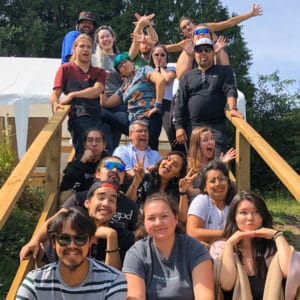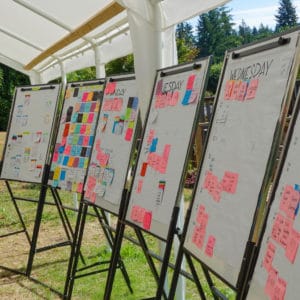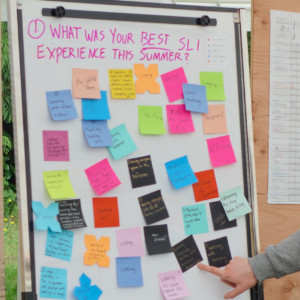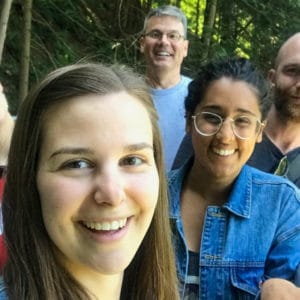Hi, everyone! My name’s Miguel, and I’m one of the Where Are Your Keys? (WAYK) interns this summer. I’ve been in the beautiful state of Oregon since Monday, June 25, spending time with fellow interns David Edwards and Sky Hopinka while meeting with Evan Gardner and so many other exciting people. Since three weeks ago, David and Sky have been spreading the magic of WAYK in China, while I’ve been sticking around with Evan playing WAYK and learning languages with him. The atmosphere’s so fresh I can imagine living here myself. Alas, I’ll only be around until September, so I hope to take advantage of the scenery, hospitality, and encouragement here before I head out.
Growing up surrounded by many different languages–Tagalog at home, English at home and school, and French and Japanese in my classes, among many others–has made me wonder what makes each of them so special. I heartily enjoy discovering language-learning materials, dissecting grammatical structures and etymologies, and disarming difficult lessons.
I also love learning and teaching. On top of those, I love learning how to teach and teaching how to learn. So when I first learned about Where Are Your Keys? from David, a classmate of mine at college, and played some rounds with him, I was excited–I had a lesson on how to combine education and language through simple, yet flexible, games! He first hunted French from me, then taught Feayran, a language he himself invented to be complicated for humans to speak. Feayran was certainly challenging–I got so caught up in the bewildering basic grammar I forgot to call “full” when I needed–but it didn’t stop me from enjoying the game. I was in awe of how much language I was able to learn and retain through the WAYK method.
I find WAYK fascinating not just because it’s a fun way to learn languages, but also because it’s easy to learn and adaptable. WAYK games can start off simple: you start with only a few techniques that are very easy to follow, followed by other techniques just in time as they become relevant to your learning. More than that, you acquire real language, using objects you can see, touch, and interact with, and use the expressions you already know to obtain other useful words and phrases without ever having to translate into English. The more language you learn, the more you can discover. Greetings and numbers, the ubiquitous starting points of most foreign-language courses, are still helpful, but in the beginning, they don’t help you hunt other bits of language. I discovered that no two games of WAYK go exactly the same because of how much input and influence learners have on the progress and flow of their learning a foreign language.
WAYK also appeals to me because of its applications to social good. I’ve been in community-service projects for years, and I’ve always felt a yearning to connect my studies and passions to help others. Because WAYK has a long history of being used to revitalize Native American languages, it helps to strengthen communities and give them a stronger sense of identity. This summer, I will be working alongside Evan in the Yurok community in the far north of California to help young people there learn their native tongue from their fluently-speaking elders. We’re very fortunate that the Yurok elders have been so eager to receive our assistance in revitalizing their language, and we look forward to learning about Yurok language and culture from them as much as they look forward to learning about WAYK and its techniques from us.
All that said, I’d like to share bits and pieces about myself. Although I was born in the Philippines, I grew up mainly in San Diego and in areas of Japan just south of Tokyo, and I graduated high school in the Charleston area of South Carolina. I graduated from Stanford University this past spring in Materials Science and Engineering (MatSci), though I’ve taken several linguistics courses there as well. This fall, I’ll be continuing my studies there toward a master’s degree, also in MatSci. For the past two years, I’ve been part of the Stanford Languages Club, and this coming fall, as co-president of the group, I’ll be spreading the wonder of WAYK throughout Stanford and to local high schools.
But why would someone like me, pursuing a master’s degree in MatSci be involved with almost-completely-disparate fields like language education and lingustics? Even though my learning interests are unrelated on the surface, I think there are core skills that underlie any discipline, and when you hone these skills in one field, you improve them in another. These abilities include paying close attention to your subject matter, identifying what should be improved, and adapting your craft to any kind of change. As one of my most accomplished classmates in MatSci pointed out to me, the materials industry requires new employees to be specially trained in their new companies, and he believes he can learn how to make this training more efficient. I’d like to pursue the same goal, both in language education and in materials education.
Knowing how best to learn and teach and how best to help others do the same is a boon to everyone. I hope that if you’re following my progress this summer, you and I can learn a lot from each other!
TAGS: Intern





